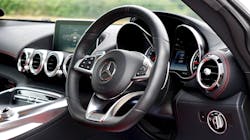July 24, 2017—Daimler and Bosch have teamed up to demonstrate driverless parking (automated valet parking) in the multi-story car park at the Mercedes-Benz Museum in Germany.
Cars now proceed without a driver to their assigned parking space in response to a command issued by smartphone, without any need for the driver to supervise the maneuver. Automated valet parking marks an important milestone on the way to autonomous driving, Daimler said.
The pilot solution at the multi-story car park of the Mercedes-Benz Museum represents the world's first infrastructure-supported solution for an automated drive-up and parking service in real-life dual operating mode. From the beginning of 2018, visitors to the museum's multi-storey car park will be able to experience the convenient service at first hand and avoid spending time parking their cars.
"We are approaching autonomous driving faster than many people suspect. The driverless parking solution at the Mercedes-Benz Museum demonstrates in impressive fashion just how far the technology has come," said Michael Hafner, head of automated driving and active safety at Mercedes-Benz Cars Development.
"Parking will be an automated process in the future. By applying an intelligent multi-storey car park infrastructure and networking it with vehicles, we have managed to realise driverless parking substantially earlier than planned," said Gerhard Steiger, director of the chassis systems control unit at Bosch.
Driverless parking is made possible by an intelligent multi-story car park infrastructure from Bosch in conjunction with the vehicle technology from Mercedes-Benz. Sensors installed in the car park monitor the driving corridor and its surroundings and steer the vehicle. The technology on board the car performs safe driving maneuvers in response to the commands from the car park infrastructure and stops the vehicle in good time when necessary.
The sensors for the multi-story car park infrastructure and the communications technology come from Bosch. Daimler is providing the private museum car park and pilot vehicles, defining the interface between infrastructure and vehicle together with Bosch and adapting the sensor technology and software in the vehicles accordingly.
Everything will then be in place to enable automated valet parking to be made available to everyone at the Mercedes-Benz Museum's multi-story car park from the beginning of 2018. Bosch and Mercedes-Benz said they intend to use this project to acquire experience regarding users' handling of automated valet parking. Other existing multi-storey car parks can be retrofitted with the infrastructure technology.



